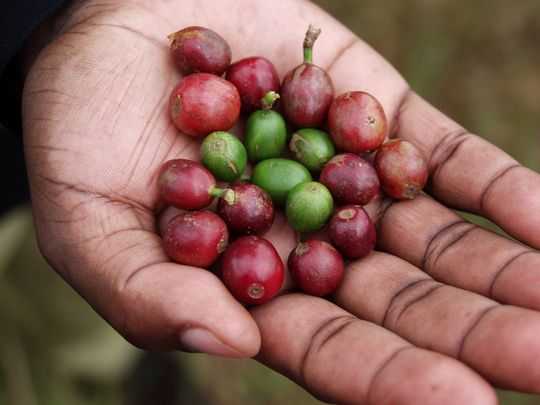Share your coffee stories with us by writing to info@comunicaffe.com.
WASHINGTON, U.S. – The USDA’s World Markets and Trade biannual report was released on Friday, after market closing. The report, that contains USDA’s official data for global trade, production, consumption and stocks, sees world coffee production in 2019/20 at 169.1 million bags, 5.4 million bags (-3.2%) down on year. Lower output is mainly due to Brazil’s Arabica trees entering the offyear of the biennial production cycle.
With global consumption forecast at a record 167.9 million bags, ending inventories are expected to retreat 2.8 million bags to 33.5 million. World exports are expected down 800,000 bags to 116.8 million as lower exports from Brazil more than offset higher shipments from Indonesia and Vietnam.
Coffee prices, as measured by the International Coffee Organization (ICO) monthly composite price index, dropped 15 percent in the last year to 93.33 in May 2019, the lowest since September 2006. http://www.ico.org/new_historical.asp
Brazil’s Arabica output is forecast to drop 7.2 million bags to 41.0 million. Good weather conditions generally prevailed in most coffee growing regions during the blossoming and fruit-forming stages. However, production is expected to drop compared to the previous season since most trees are in the off-year of the biennial production cycle.
Crop quality is expected lower than last year because trees in many areas had multiple stages of maturity when the coffee cherries were harvested. The bulk of the Arabica harvest started in May and June. The Robusta harvest is forecast to continue expanding to reach a record 18.3 million bags, an increase of 1.7 million.
Abundant rainfall aided fruit development in the major producing state of Espirito Santo, while good crop management practices supported a steady increase in the state of Rondonia.
Most of the Robusta harvest started in April and May. However, the combined Arabica and Robusta harvest is forecast down 5.5 million bags to 59.3 million.
With reduced supplies, bean exports are expected to drop 2.5 million bags to 33.5 million and ending stocks are forecast to decline 1.0 million bags to 2.9 million. Consumption is expected to continue rising to a record 23.5 million bags.
Vietnam’s production is forecast to add 100,000 bags to a record 30.5 million.
Between January and early April 2019, the main coffee regions in the Central Highlands experienced seasonally dry and sunny weather, and trees were irrigated. The rainy season was slightly delayed, but adequate for good flowering and fruit-set.
With black pepper prices falling over the last three years, farmers are no longer replacing coffee trees with pepper. However, some farmers have begun to plant durian, mango, avocado, and passion fruit trees in their coffee orchards.
Over 95 percent of total output is Robusta, because Arabica trees produce good cherries only when grown at least 1,000 meters above sea level. Hence, expansion is limited due to the remoteness of these locations and the logistical difficulties related to transporting and processing the coffee. Bean exports are forecast 1.0 million bags higher to 25.5 million, while ending stocks remain unchanged at 2.1 million bags.
Total output for Central America and Mexico is forecast nearly unchanged at 19.1 million bags as some countries in the region continue to struggle with the coffee rust outbreak that first lowered output in 2013/14. Gains in Mexico on favourable weather are expected to offset losses in Honduras. El Salvador, Guatemala, and Panama are flat at 650,000 bags, 3.6 million bags, and 100,000 bags, respectively, as these countries continue to struggle with rust and output remains below their pre-rust level.
Nicaragua is forecast 200,000 bags lower to 2.3 million as financial constraints are expected to lead to reduced inputs and yields. Bean exports for the region are forecast to lose 600,000 bags to 15.5 million mainly due to lower exportable supplies in Honduras. Over 45 percent of the region’s exports are destined for the European Union, followed by about one-third to the United States.
Colombia’s production is forecast flat at 14.3 million bags on normal growing conditions. The National Federation of Coffee Growers of Colombia (FEDECAFE) estimates that since 2012, about half of the 940,000 hectares of coffee have been renovated, mostly with rust-resistant varieties.
This effort raised yields nearly one-third to 18.2 bags per hectare and lowered the average age of coffee trees to 7 years (from 15).
FEDECAFE and the Colombian government renovated an estimate 80,000 hectares in 2018, with the goal of renovating 90,000 hectares annually to reach the production goal of 18 million bags in the coming years. Bean exports are seen unchanged at 12.3 million bags, while ending stocks are expected to dip slightly to 500,000 bags.
Indonesia’s production is forecast to gain a modest 100,000 bags to 10.7 million, with the gain split evenly between Arabica and Robusta output. Robusta production is expected to reach 9.5 million bags on favorable growing conditions in the lowland areas of Southern Sumatra and Java, where approximately 75 percent is grown.
Despite heavy rainfall in West Java that delayed its Arabica harvest, output is expected up slightly. Bean exports are forecast to rebound 1.6 million bags to 6.5 million, boosted by last year’s elevated ending stocks.
European Union imports are forecast down 500,000 bags to 48.5 million and account for over 40 percent of the world’s coffee bean imports. Top suppliers include Brazil (29 percent), Vietnam (25 percent), Honduras (8 percent), and Colombia (6 percent). Ending stocks are expected down 700,000 bags to 13.1 million.
The United States imports the second-largest amount of coffee beans and is forecast 400,000 bags higher to 26.5 million. Top suppliers include Brazil (24 percent), Colombia (22 percent), Vietnam (15 percent), and Guatemala (6 percent). Ending stocks are forecast up 200,000 bags to 6.9 million.
Revised 2018/19
World production is unchanged from the December 2018 estimate of 174.5 million bags.
- Brazil is raised 1.4 million bags to 64.8 million on higher yields in Minas Gerais.
- Mexico is down 500,000 bags to 4.1 million as rust damage was higher than anticipated.
- Indonesia is reduced 300,000 bags to 10.6 million following heavy rains during cherry
development that lowered Robusta yields.
World bean exports are raised 600,000 bags to 117.6 million.
- Brazil is up 4.0 million bags to 36.0 million on higher-than-anticipated stocks drawdown and greater exportable supplies.
- Indonesia is down 2.1 million bags to 4.9 million as several importing countries switched to Brazil’s lower-priced Robusta.
- Vietnam is lowered 1.0 million bags to 24.5 million as farmers reduced sales, adding to stocks.
World ending stocks are reduced 700,000 bags to 36.3 million.
- Brazil is lowered 3.0 million bags to 3.9 million on higher shipments.
- Indonesia is up 1.5 million bags to 2.4 million on lower shipments.
- Vietnam is raised 1.0 million bags to 2.1 million on lower shipments.















